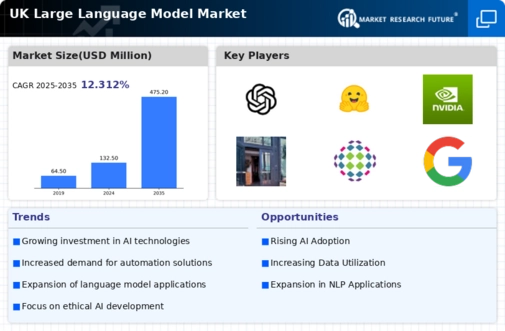Rising Demand for Automation
The large language-model market is experiencing a notable surge in demand for automation across various sectors in the UK. Businesses are increasingly seeking to enhance operational efficiency and reduce costs through the implementation of automated solutions powered by advanced language models. This trend is particularly evident in industries such as finance, healthcare, and customer service, where the need for rapid data processing and analysis is paramount. According to recent estimates, the automation market in the UK is projected to grow at a CAGR of approximately 25% over the next five years, indicating a robust appetite for technologies that can streamline workflows. As companies strive to remain competitive, the integration of large language models into their operations is likely to become a standard practice, thereby driving growth in the large language-model market.
Emergence of Multilingual Capabilities
The large language-model market is witnessing the emergence of multilingual capabilities as a critical driver of growth in the UK. With the increasing globalization of businesses, there is a pressing need for language models that can understand and generate content in multiple languages. This demand is particularly relevant in sectors such as e-commerce, travel, and international relations, where effective communication across language barriers is essential. Recent studies indicate that the multilingual NLP market is expected to grow by over 30% annually, reflecting the urgency for businesses to cater to diverse audiences. As organizations seek to enhance their global reach, the development of advanced multilingual language models is likely to play a pivotal role in shaping the landscape of the large language-model market.
Increased Focus on Data Privacy and Security
The large language-model market is increasingly influenced by the heightened focus on data privacy and security in the UK. As businesses adopt language models, they must navigate complex regulations surrounding data protection, such as the General Data Protection Regulation (GDPR). This regulatory landscape compels organizations to implement robust security measures to safeguard sensitive information while utilizing language models. Consequently, there is a growing demand for solutions that ensure compliance with data privacy standards, which may drive innovation within the large language-model market. Companies that prioritize data security are likely to gain a competitive edge, as consumers become more discerning about how their data is handled, thereby shaping the future trajectory of the market.
Government Initiatives Supporting AI Development
The large language-model market is benefiting from various government initiatives aimed at fostering AI development in the UK. The UK government has launched several programs and funding opportunities to encourage research and innovation in artificial intelligence, including language models. These initiatives are designed to position the UK as a leader in AI technology, with a focus on ethical and responsible development. For instance, the UK AI Strategy outlines plans to invest £1 billion in AI research and development over the next five years. Such government support not only enhances the capabilities of the large language-model market but also attracts private sector investment, creating a conducive environment for growth and collaboration between academia and industry.
Expansion of Natural Language Processing Applications
The large language-model market is witnessing an expansion in the applications of natural language processing (NLP) technologies within the UK. As organizations increasingly recognize the value of extracting insights from unstructured data, the demand for sophisticated NLP solutions is on the rise. Industries such as legal, marketing, and education are leveraging language models to enhance communication, automate content generation, and improve customer engagement. Recent data suggests that the NLP market in the UK is expected to reach £1.5 billion by 2026, reflecting a growing investment in technologies that facilitate better understanding and interaction with human language. This expansion of NLP applications is likely to propel the large language-model market forward, as businesses seek to harness the power of language models to drive innovation and improve service delivery.
























Leave a Comment